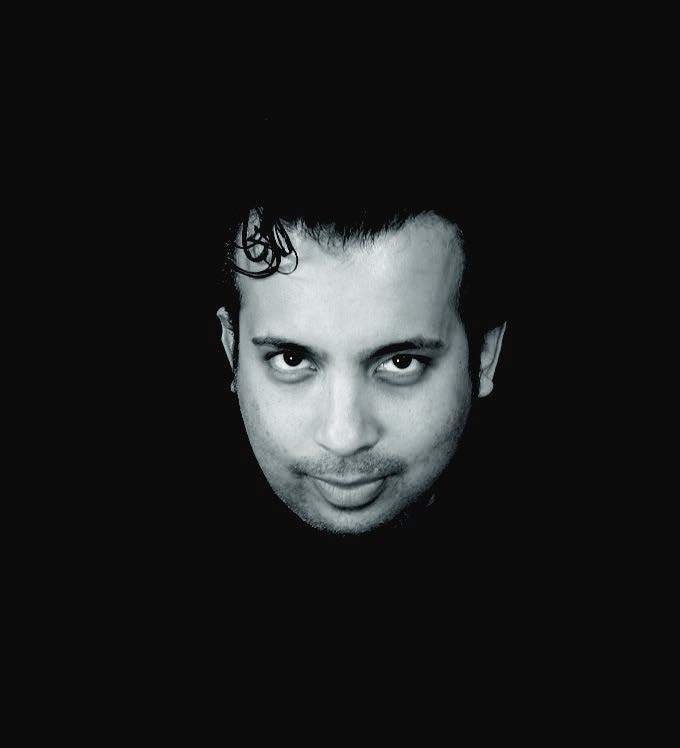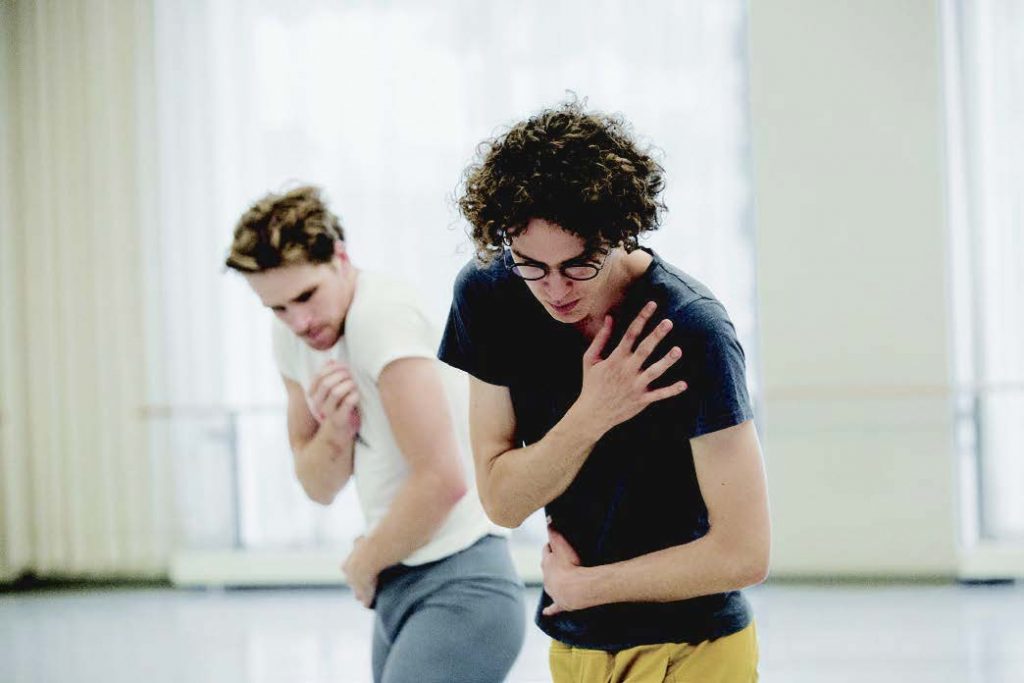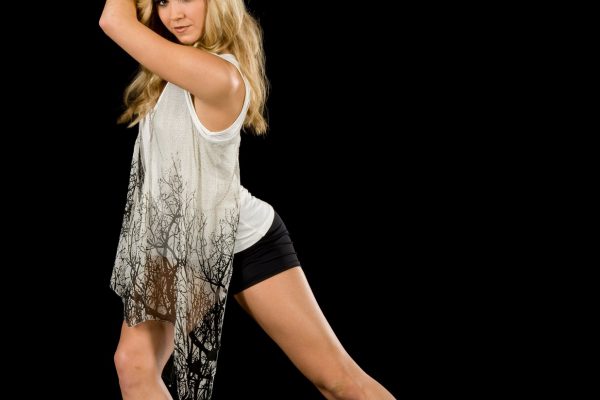This article was originally published in our July/August 2020 print issue.
Where is Queer dance performance in Canada, and who are Canada’s Queer dance artists? The country has a rich history of LGBTQ2+ theatre and music. Playwrights such as Michel Tremblay and evalyn parry, performance artists such as Cassils and Nina Arsenault and musicians including Rufus Wainwright and k.d. lang have all garnered global attention for their work as Queer artists. But dance work from Canada that is explicitly Queer seems less globally known.
To excavate Queer dance in Canada, I connected with some of the leading Queer dance artists in Canada today. I spoke with Robert Binet, choreographic associate at The National Ballet of Canada, who challenges the norms of ballet; Twysted, a ballroom dancer and community educator who has been at the fore of the resurgence of vogue culture in Toronto’s LGBTQ2+ community; and Hari Krishnan, a scholar/choreographer/dancer whose work merges Indian classical dance and western aesthetics.
Stephen Low I’d like open up our conversation by asking how each of you defines Queer.
Twysted I am old-school! My definition of Queer means to fall in the LGBT identities. While Trans is not a sexual identity, there is no Queer community without the presence of Trans identities.
Robert Binet I also use it most in describing sexuality, and it’s a beautifully broad term I’ve seen people describe themselves with. There’s a beautiful openness to it.
Hari Krishnan For me, Queer is also about transgression of conventions and radical inclusivity. Queer cannot and does not silence any particular class or group. I do not limit my inquiry to LGBT people. I think of Queer as an interrogation of difference. This involves considering the complex thread in alternate possibilities and realities.

SL How do each of you understand your work as Queer? How is it Queer? Why is it Queer?
RB First and foremost, my work could be considered Queer because I try to challenge gender norms in ballet. They are so rigid; it’s hard for someone to not challenge them. In classical partnering, the woman is always supported by the man. My work creates a vocabulary that can come from this classical partnering technique but shifts the power dynamics. This involves asking questions about consent. How can I make it look like both parties want everything that is happening to be happening? There are sometimes differences in power, but that has to be intentional and not look like I am falling back on the conventions of the form. I think some of the work I make is Queer. If you look at it in the context of ballet, all of it is.

HK In general, my work is Queer because I too subvert normative gender roles in dance. In my work, cis gender expectations are subverted, reversed and turned on their heads. I subvert gendered ways of movement and I choreograph same-sex partnerships. Additionally, Queerness is a riffing-off of my understanding of dance history. How I weave in critical dance history into my work is another Queer act of critical pedagogy. My work challenges expected notions of stereotypes. For example, in Quicksand, I choreographed nine contemporary male dancers to abstract and riff off nine conventional forms of emotions which are typical of popular representations in Indian classical dance performed in a heteronormative context. I recontextualize these archetypical heteronormative states of being, transforming them into nine Queer states of being. From Queer realities and Queer possibilities, gay or Trans or Two-spirited, the dancers whom I cast in Quicksand could bring their own perspectives into the choreography.
In general, my work is Queer because I too subvert normative gender roles in dance. In my work, cis gender expectations are subverted, reversed and turned on their heads.
Krishnan
My recent choreographic duet, Śiva kissed Visnu (created in 2020 for two openly gay bharatanatyam trained dancers), is an example of my Canadian Queer work rooted in a culture-specific dance form. It is an abstract love duet that has nothing to do with religion or mythology but subverts popular, gendered representations of Indian dance, including male-female partnering and the inherent lack of intimacy in the projection of romantic love that are endemic to the form today. The names Siva and Visnu are common Indian names of many men, especially in South India (and the diaspora), and the premise of the duet is to create a more honest humane possibility of two brown men in love, drawing from Indian classical dance as a contemporary choreographic language/resource. Representations of male dancers and popular representations of the sacred are skewed in my work and made more relevant in this socio-political unsettling time.
T Voguing is Queer because it was created by Black Queer and Trans bodies, for the liberation of Black Queer and Trans bodies. Voguing breaks all the rules of masculinity. In fact, it comes from a place of femininity. Whether you are masculine or feminine, you have to tap into the energy of the Trans femme women that created this dance to vogue. When I vogue, I dance extremely ‘Queerly’ and it better be visible or else I am not doing it right. Along with paying homage to Black Queer and Trans femmes, the work I do as a community educator, which is closely tied to my work in vogue, is shaped by the community I represent, and therefore, yes – my work is Queer.

SL How is voguing involved in your work as a community educator?
T First of all, voguing is a dance, but it is not really just a dance. It comes from the ballroom community. Voguing is the most popular part of a ball because it is dance. But when people come to the ball, there are other categories and events. And at these balls, there is community education. I work at BlackCAP (Black Coalition for AIDS Prevention) as an outreach educator. The outreach we do at BlackCAP is more successful when it happens at a ball. So many people will not go to BlackCAP programming because there’s stigma attached to it, but we can reach them in the ballroom. When it comes to educating the community, disseminating the information is more effective in the ballroom. I can actually reach out to the people who need it. And also, it brings people in. The dancing goes out there and then brings them in.
SL Do you describe your work as Queer, either in marketing, advertising, grant applications or discussion?
RB I’ve spent as little time as I can describing my work. We all have such specific relationships to words, and the way I describe it can mean something completely different to someone else. It’s not a form that is well-suited to description in words. My work probably is Queer. I haven’t needed to categorize my work in that sense. I would describe it as Queer if that was helpful in the context.

T When I am brought to vogue in heterosexual spaces, it is very clear that the work is Queer. The smallest vogue gestures in heterosexual spaces receive so much attention, but in Queer spaces it just is. Voguing comes from Black Trans femme women, so when I’m voguing, I’m paying homage to those who have paved the way for me. That’s why I try to vogue like a Trans woman. Vogue femme. You have to understand that history and that spirit, and that has to overtake you. There’s a sense of self-liberation, especially for the Queer person. Especially for the Queer person who has experienced oppression. When you do all the things that you were told not to do, moving in ways that you were told not to move, and you’re doing it anyway, and being celebrated on the floor for it, there’s no other feeling like that.
HK Of course, I use the word Queer liberally but am also interested in the mediated ways Queer studies and dance impact each other. These emerge from the skewed way in which I view the world and normalcy. Being a scholar-artist makes this possible. It is informed by a solid core and knowledge base that allows me to play and question and challenge and rupture. My work is replete with complexity and cobwebs. There is no easy or obvious middle ground between critical scholarship/aesthetic representations and lived life experiences.
SL What is the status of Queer dance in Canada?
RB Most contemporary dance can be classified as Queer, but it’s contextual. In ballet, shifting gender norms is Queer. There’s not a lot of ballet that is Queer. But in the contemporary world, there’s plenty. It does come down to context, but in this case, genre. I do think we live in a progressive-minded culture here in Canada, and I hope that lends itself to Queerness becoming more present in ballet. There’s much more openness to it here than in other countries. It’s a younger art form here, and so there’s less sense of what ballet is supposed to be. We are still inventing what Canadian ballet is. There’s such a heavy legacy of ballet in Europe and the United States. There’s a much wider lens and point of view here. And that can lend space to Queerness. There’s a remarkable openness in the arts here, and what ballet is needing and wanting is a much wider perspective, which is available here.

T As far as vogue, it is growing! There is now a ballroom community in Montréal, Vancouver, Halifax and Ottawa, and vogue is leading the charge. Montréal is growing; there’s a scene. There isn’t a full scene in Vancouver, but there are some balls. And Halifax had a ball last year. These growing scenes have the same impact on those communities as it did for me. Anywhere that people are feeling oppressed, which is everywhere in different ways, a ballroom scene can provide a place for community and self-expression. Being a male dancer in the dance industry, you are pressured to dance masculine or present yourself in a certain way with a certain body. But in the ballroom scene, a slender man’s body is celebrated. A thicker man’s body is celebrated too. In the ballroom, people can feel that same joy of being authentic and performing an identity that they were told to suppress or hide. It feels … you’ll see it. I might say this now, it might be cliché, but even when I teach a workshop, I get the same responses from people by giving them permission to move in a way they are not given anywhere else. Giving them permission to move in ways they really want to, to challenge masculinity and gender. It has an impact here, just like drag, and drag is also growing in Canada.
HK I owe a large debt to Canada. First of all, I owe a large debt to Winnipeg, where I first discovered contemporary dance through the work of Canadian dance visionary Rachel Browne. I’ve become my own person because of Canada. Canada allowed me to become my own person. Canada is pure heaven in terms of positive reaffirmation for me and my art. Right-wing politics here do not even compare to in other parts of the world. My Queer work has always focused on ‘choosing love’ in a toxic environment of homophobia, religious fundamentalism and misogyny.

SL What were some of the Queer audience moments you experienced when you’ve presented Queer dance?
RB I’d like to share a story from a work of mine that premiered in the fall, Orpheus Alive. The basic premise was that the audience were the gods who held Orpheus’s fate in their hands. There was speaking in the ballet, where the lead female dancer, Orpheus, would address the gods directly. Towards the end of the ballet, she says to the gods (I’m paraphrasing) that either they need to let her see Eurydice again for just a moment or she will curl up and lie on the ground at the gates of the underworld until she dies. At the end of the monologue, Orpheus began to curl up on the ground, making good on her promise. In one performance, a woman from the audience screamed ‘You should live anyways!’ That moment has stayed with me more than anything from the whole project. The fact that we created an environment in a very traditional opera house where someone felt the desire to shout something to the protagonist, and felt that there was space for their own voice inside a ballet, was just the best feeling for me. It was certainly a Queer response for ballet.
HK Some of the Queer moments of audience reception have emerged in reviews from the press. Some directly reflect how my work challenges gender norms, such as when a critic remarked, “As with many of his works, gender and sexuality figure prominently. In this case, Krishnan specifically confronts the normative notions of binary gender that Western society is obsessed with, and takes on the legal prohibitions against homosexuality in India.” [Chris Dupuis, Xtra]
The fact that we created an environment in a very traditional opera house where someone felt the desire to shout something… was just the best feeling for me.
Binet
T When someone dips at a ball, everyone says ‘Ow,’ celebrating the fabulous dips. That’s Queer. It’s so funny. When my brother, who’s straight, was the only person in my family who knew I was voguing, he lived with me. He would come from the kitchen to watch me and my friends watch clips from previous balls. When we watched, everyone would tilt their head and snap every time a performer would dip. My brother, he was looking at us and trying to figure out how and why we would tilt our heads and snap in unison. For me, this was an example of how the audience plays as much as a part in the ball as the performer, and that is a Queer audience moment.
Because of the need to keep physical distance during the COVID-19 pandemic, these interviews were conducted online and edited for clarity and concision.
***
Sommaire
Où est la danse Queer en spectacle au Canada, et qui sont les artistes de danse Queer au Canada ? Le pays a une riche histoire de théâtre LGBTQ2+. Des dramaturges comme Michel Tremblay et evalyn parry, des artistes de la performance comme Nina Arsenault et les musiciens comme Rufus Wainright et k.d. lang sont tous reconnus mondialement pour leur travail comme artiste Queer. Mais la danse explicitement Queer est absente, invisible ou du moins, elle n’est pas présentée comme Queer. Stephen Low a parlé avec trois artistes sur le statut de la danse Queer au Canada: Robert Binet, associé chorégraphique au National Ballet of Canada, qui met au défi les normes du ballet; Twysted, un danseur ballroom et éducateur communautaire qui est à l’avant-plan de la résurgence et de la culture de voguing dans la communauté LGBTQ2+ à Toronto; et Hari Krishnan, un chercheur, chorégraphe et danseur qui combine la danse classique indienne et l’esthétique occidentale.
Dance Media Group strengthens the dance sector through dialogue. Can you help us sustain national, accessible dance coverage? Your contribution supports writers, illustrators, photographers and dancers as they tell their own stories. Dance Media Group is a charitable non-profit organization publishing The Dance Current in print and online.

Tagged:






